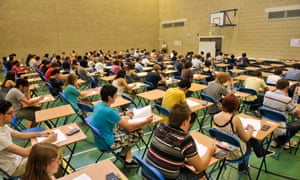The US Leaves Some of Its Most Gifted Kids Behind in Education, Because They’re Poor
Jonathan Wai and Frank C. Worrell | March 25, 2016
For the first time in the history of our country, the educational skills of one generation will not surpass, will not equal, will not even approach, those of their parents.In 1996, education researchers Camilla Benbow and Julian Stanley published a paper reviewing decades of evidence showing the achievement of students with high intellectual potential had markedly declined, building upon A Nation at Risk by arguing:
Our nation’s brightest youngsters, those most likely to be headed for selective colleges, have suffered dramatic setbacks over the past two decades. This has grave implications for our country’s ability to compete economically with other industrialized nations.
 |
| Source: http://www.theguardian.com/education/2015/mar/17/poor-bright-pupils-aged-11-fall-behind-by-a-levels-study-finds |
<more at http://qz.com/644393/the-us-leaves-some-of-its-most-gifted-kids-behind-in-education-because-theyre-poor/; related articles and links: http://bbs.sagepub.com/content/3/1/122 (Helping Disadvantaged and Spatially Talented Students Fulfill Their Potential Related and Neglected National Resources. Johnathan Wai and Frank C. Worrell. Behavioral and Brain Sciences, March 2016 vol. 3 no. 1 122-128. doi: 10.1177/2372732215621310. [Abstract: For at least the last half-century, we have underserved advanced learners, losing countless minds and corresponding innovations. The scientific evidence is clear on educational interventions that are most effective and relatively easy to implement for this population. Despite this, such educational opportunities are not readily available to all students. Whereas financially advantaged students can access opportunities outside of school that develop their talents, financially disadvantaged students cannot, and their talents largely go underdeveloped. Another underserved population is spatially talented learners, who can reason by using well-structured visual images. They are often underidentified and neglected in standardized tests and school systems that emphasize verbal and mathematical skills. Although all advanced learners deserve to have their talents developed to the fullest, a policy focus on the financially disadvantaged and spatially talented would be an actionable and effective strategy to quickly level the playing field. Because spatial reasoning is less correlated with socioeconomic status than are math and verbal reasoning in the population, identifying spatial talent will also identify more students from low-income and disadvantaged backgrounds. A policy focus on helping and challenging such disadvantaged students would contribute to fulfilling their talent and increasing their well-being; it also would increase demographic and intellectual diversity among the ranks of the highest achievers and benefit society. The current K-12 federal educational allocation to advanced learners is currently near zero. Research suggests a small early investment in advanced learners would pay off in intellectual and technological innovations, as well as GDP.]) and http://www.nber.org/papers/w18586.pdf (The Missing "One-Offs": the hidden supply of high-achieving, low income students. Caroline M. Hoxby and Christopher Avery. NBER Working Paper Series 18586. December 2012, Revised December 2012 JEL No. I21,I23,I24 [Abstract: We show that the vast majority of very high-achieving students who are low-income do not apply to any selective college or university. This is despite the fact that selective institutions would often cost them less, owing to generous financial aid, than the resource-poor two-year and non-selective four-year institutions to which they actually apply. Moreover, high-achieving, low-income students who do apply to selective institutions are admitted and graduate at high rates. We demonstrate that these low-income students' application behavior differs greatly from that of their high-income counterparts who have similar achievement. The latter group generally follows the advice to apply to a few "par" colleges, a few "reach" colleges, and a couple of "safety" schools. We separate the low-income, high-achieving students into those whose application behavior is similar to that of their high-income counterparts ("achievement-typical" behavior) and those whose apply to no selective institutions ("income-typical" behavior). We show that income-typical students do not come from families or neighborhoods that are more disadvantaged than those of achievement-typical students. However, in contrast to the achievement-typical students, the income-typical students come from districts too small to support selective public high schools, are not in a critical mass of fellow high achievers, and are unlikely to encounter a teacher or schoolmate from an older cohort who attended a selective college. We demonstrate that widely-used policies–college admissions staff recruiting, college campus visits, college access programs–are likely to be ineffective with income-typical students, and we suggest policies that will be effective must depend less on geographic concentration of high achievers.])>

No comments:
Post a Comment